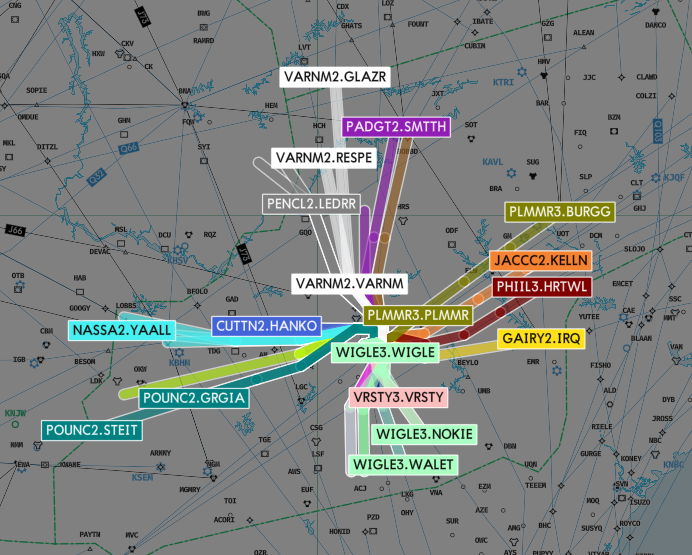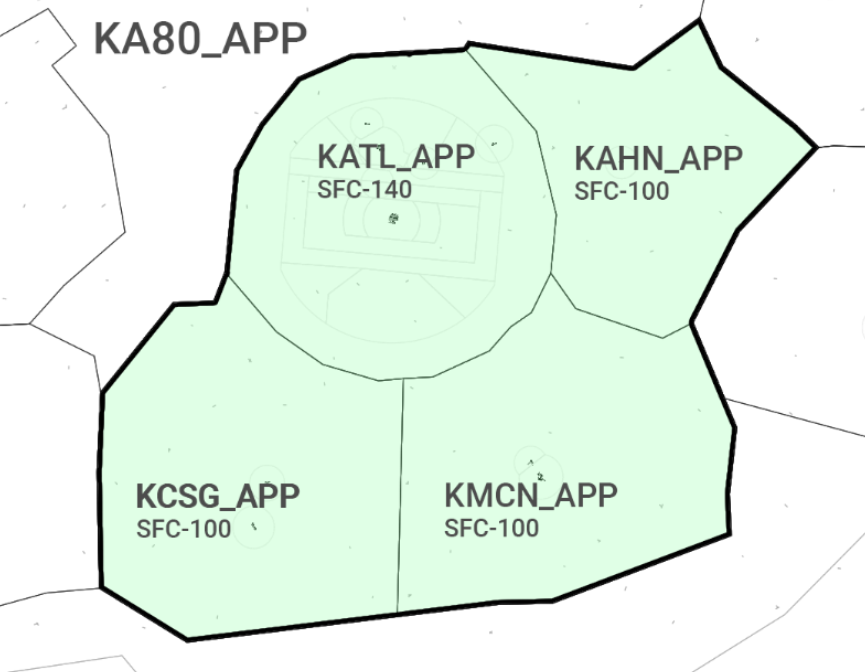¶ Standard Operating Procedures
¶ IFR
| SID | SID Type | Pronounciation | Aircraft | Runways | Initial Climb |
|---|---|---|---|---|---|
| ATL# | Vectors | Atlanta | All | All | Prop 4000, Jet 10000 |
| BANNG# | RNAV | Bang | Jet | All | 10000 |
| CUTTN# | RNAV | Cutting | Jet | All | 10000 |
| GAIRY# | RNAV | Gary | Jet | All | 10000 |
| HAALO# | RNAV | Halo | Jet | All | 10000 |
| JACCC# | RNAV | Jack | Jet | All | 10000 |
| KAJIN# | RNAV | Kay-Jin | Jet | All | 10000 |
| NASSA# | RNAV | Nasa | Jet | All | 10000 |
| PADGT# | RNAV | Padgot | Jet | All | 10000 |
| PENCL# | RNAV | Pencil | Jet | All | 10000 |
| PHIIL# | RNAV | Fill | Jet | All | 10000 |
| PLMMR# | RNAV | Plummer | Jet | All | 10000 |
| POUNC# | RNAV | Pounce | Jet | All | 10000 |
| SMKEY# | RNAV | Smokey | Jet | All | 10000 |
| SMLTZ# | RNAV | Smelts | Jet | All | 10000 |
| VARNM# | RNAV | Varnom | Jet | All | 10000 |
| VRSTY# | RNAV | Varsti | Jet | All | 10000 |
| WIGLE# | RNAV | Wiggle | Jet | 8L/R 9L/R | 10000 |
| ZELAN# | RNAV | See-Lan | Jet | 27R | 10000 |
- All aircraft shall fly RNAV departures if possible.
- Aircraft requesting below 10,000 feet for a final altitude must be on the ATL# departure procedure.
- Turbojet aircraft may not be assigned a final altitude lower than 5,000 feet.

¶ Departure Exit Fixes

¶ IFR Clearance (RNAV)
IFR (RNAV) Example:
Cleared to Miami Intl airport via the BANNG# departure, then as filed. Climb via the sid, expect FL350 10 minutes after departure. Departure frequency 122.8, squawk 2001.
¶ IFR Clearance (Radar Vectors)
If no RNAV departure is useable you can use Atlanta# SID and instruct aircraft to expect radar vectors to first fix.
Example:
Cleared to Miami Intl airport via the Atlanta1 departure, radar vectors LUCKK, then as filed. Maintain 10000, expect FL350 10 minutes after departure. Departure frequency 122.8, squawk 1234.
¶ IFR Squawk codes
via Aurora or 2001-2777
¶ VFR
Atlanta International airport is surrounded by class B airspace. Aircraft entering class B airspace VFR require a clearance in accordance with 7110.65 Chapter 7, section 9-2.
VFR Deaprture Example:
Cleared out of the Atlanta class bravo airspace, maintain VFR at or below 2500 until further advised. Departure frequency 122.8. Squawk 1201.
VFR Local Pattern Example:
Cleared into the Atlanta class bravo airspace, pattern altitude 1000, expect left closed traffic runway 8L, squawk 0301.
Ground is responsible for all movement areas except between runways 28/10 and 27L/9R.
Assign departure runways based on direction of flight:
- 270-090: 26L/8R
- 090-270: 27R/9L
Aircraft parked at south cargo camp should expect runway 27R/9L for departure.
Arriving GA traffic and private jets shall be routed to park at the northern ramps.
¶ East Flow

¶ West Flow

¶ A380 Operations
- A380s are only authorized on the Center Complex (Runways 9L / 27R and 9R / 27L).
- Normally, A380s will land Runway 9R / 27L and depart Runway 9L / 27R. Upon landing, A380s will roll to the end of the runway. A380s are limited to crossing Runway 9L / 27R at Taxiways J, K, N13, P and U. They will utilize standard hold short lines at ATL.
- A380s are only authorized on the following taxiways: D (north of Runway 9L / 27R), J, K, L, LA, LB, LC, L3, L10, L12, L14, L16, M (except between L14 and L16), M16, M18, N between SC and U, N12, N13, P, R, SC, T (north of Runway 9L / 27R), and U.
- Category H or I (small) aircraft may not cross Runway 9L at Taxiway P until a departing A380 has passed the departure end of the runway
¶ Runway Crossings
When requesting a runway crossing from TWR, specify the runway and the point at which crossing will occur, using the format of "Cross (rwy) at (intersection)?". Callsign is not required.
TWR's approval is only valid for one aircraft to cross as specified.
¶ Transponder
Atlanta International Airport is facilitated with ASDE–X (Ground Radar). Pilots are required to operate transponders on mode 'active'.
¶ Airspace
Atlanta International Airport is surrounded by class B airspace. Aircraft operating in class B airspace receive services as outlined in 7110.65 Chapter 7, section 9.
¶ Area of Responsibility
- TWR owns airspace from the surface up to and including 4,000 feet MSL (7NM around KATL airport)
- TWR owns all taxiways between 8s-26s and between 9s-27s
East ops

West ops

¶ Runway configuration
Wind calm: West Ops
East Ops:
DEPARTURES: 8R, 9L
ARRIVALS: 8L, 9R, 10
West Ops:
DEPARTURES: 27R, 26L
ARRIVALS: 27L, 26R, 28
¶ Runway Distance Remaining
East Ops

West Ops

¶ VFR transitions
VFR aircraft shall transition over KATL midfield northbound or southbound at 4500ft MSL.These aircraft will be under Air Traffic Control of the overlying facility (APP or CTR)

¶ APP
Atlanta APP serves multiple airports. Runway assignments will be instructed on initial contact.
TMA ATIS: ☑️
METAR Station: (Empty)
Landing: (Empty)
Departing: (Empty)
Transition Level: ☑️ 180
Transition Altitude: ☑️ 18000
Remarks: (Empty)
¶ DEL/GND/TWR
METAR Station: KATL
ARRIVAL: 26R 27L 28 or 8L 9R 10
DEPARTURE: 26L 27R or 8R 9L
Transition Level: ☑️ 180
Transition Altitude: ☑️ 18000
Remarks: (Empty)



